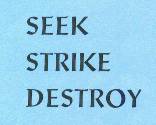
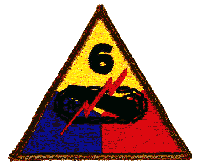 |
History of the |
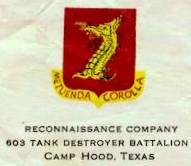 |
This section of the 6th Armored Division web site contains the complete text of Seek Strike Destroy, the WW II unit history of 1st Platoon, Recon Co., 603rd Tank Destroyer Battalion, 6th Armored Division. This history was written at the end of World War II by M/Sgt. Nick O. Civarra, and was published in Germany. The photos shown in this web presentation are from Nick Civarra's personal collection and did not appear in the original document.
Note: this document is not to be confused with the book by the same name, written by Patrick J. Chase and published by Gateway Press in 1995, covering the history of the 894 Tank Destroyer Bn.
Many thanks to Nick Civarra and Dennis Little (son of S/Sgt George S.
Little) for making this document and photos available for this web site.
To those
men of the 1st Platoon, and to Lt. Walter R. Fick their gallant and courageous
leader . . .
This
book is dedicated.
![]()
"SEEK"
"STRIKE"
"DESTROY"
The above is the motto of the Tank Destroyers. On the following pages is the story of the men whose job it is to do the seeking, and as often as not have to strike and destroy also. Lightly armored, fast travelling, these are the men who lead the Armored Divisions, relying on deception and speed, they seek the routes to the objectives. Attempting to by-pass heavy resistance, fight-through it if necessary. This is the story of the 1st Platoon of Reconnaissance Company, 603rd Tank Destroyer Battalion.
A Platoon of 1 Officer, 19 enlisted men, two armored cars and four jeeps. In the middle of DECEMBER 1941 the 603 TD Bn. consisting of Hqs. Co., three gun Companies (A-B-C) and Pioneer Co. was activated at Ft. Lewis, Washington, commanded by Lt. Col. Barkes. Col. Barkes was with the Bn. a short while and then Major Rutte became the new Bn. Commander.
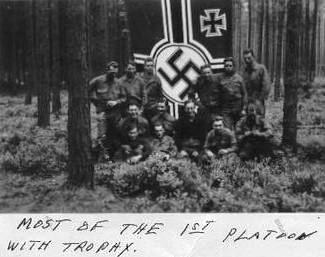
During the month of APRIL 1942 the Bn. made its first move, convoying to Ft. Ord, California. It was at Ft. Ord that Pioneer Co. without changing its personnel became Reconnaissance Co. consisting of Hqs. platoon, 1st, 2nd, 3rd recon. platoons, and the 4th platoon which remained a pioneer platoon. The company C.O. at that time was Capt. Grover; during our stay at Ft. Ord. Capt. Grover was transferred and Capt. Edwards replaced him. Bn. C.O. was also replaced by Major Parks.
SEPTEMBER 1942 the Bn. again moved, this time crosscountry by train to Camp Pickett, Virginia. After a short while in Virginia, Rcn. Co. was taken over by Capt. Tormey. In the early part of JANUARY 1943 the Bn. again moved by train to the newly formed Tank Destroyer center at Camp Hood, Texas. In Camp Hood, Rcn. Co. again welcomed a new C.O., this time Capt. Allan R. Scullen, and also a new Bn. C.O. Lt. Col. Minniece. Early in April 1943 the BN left Camp Hood for Louisiana, where they were on maneuvers until the early part of June, upon completion of the maneuvers the Bn. convoyed to Camp Shelby, Miss. where they stayed until the middle of JULY and then returned to Camp Hood, Texas. Once again the Bn. said goodbye to Camp Hood, when in the latter part of JANUARY 1943 they left for Camp Maxey, Texas, only there a short time they again moved, this time to Camp Kilmer, New Jersey during the last few days of MARCH. APRIL 8th 1944 the Bn. left Camp Kilmer, and by train went to the docks where they loaded on the "Queen Mary'', a former luxury liner.
Monday morning APRIL 10th 1944 the boat left New York harbor, and on the 17th of APRIL dropped anchor in the Firth of Forth, in the vicinity of GLASKOW, SCOTLAND. The next day we debarked, loaded on a train in GOUROCK, and after an interesting 300 mile trek which took them through CARLISLE, LEEDS, MANCHESTER, STAFFORD and the destination CANNOCK, ENGLAND. On the 23rd of MAY the BN. left CANNOCK and by convoy proceeded to SHERBORNE, ENGLAND, and were billeted in the Manor House of Sherborne, on the trip we passed through WALSALL, BIRMINGHAM, WOLVERHAMPTON, STRAFFORD-on-the-AVON. During our stay at SHERBORNE some of the men in Rcn. Co. made visits to LONDON, also to LIVERPOOL to get some vehicles, and also to the Island of ANGELESY off the coast of WALES to attend an anti-aircraft gunnery & recognition school. The Bn. also made a trip to the vicinity of DOVER where they completed firing problems.
The Bn.
was attached to the Sixth Armored Division while in ENGLAND. And it was
while they were at Sherborne that D-day took place. It was also at Sherborne
that Rcn. Co. modified their vehicles and prepared them for combat.
On the
morning of JULY 16th 1944 Rcn. Co. left SHERBORNE MANOR, and that evening
arrived at a marshalling area south of SALISBURY, ENG. The next day they
drove all afternoon and late in the day arrived at the docks at SOUTHAMPTON,
ENG. Early morning of JULY 18th Rcn. Co. personnel, following their vehicles,
were loaded on the liberty ship "PEARL HARBOR", at the crack of dawn the
ship left the dock, and that night we dropped anchor somewhere off the
coast of FRANCE. The next day they commenced unloading vehicles, and by
the 20th of JULY Rcn. Co. complete had unloaded at UTAH BEACH and were
assembled in the vicinity of BARNVILLE, FRANCE, after driving across the
CHERBOURG PENN. passing through ST. MERE INGLESE, MONTEBOURG, VALONGES,
and ST. SAVEUR, it was Rcn's first view of FRANCE and some of its towns
had met the full fury of battle.
At this time the 1st platoon of Rcn. Co. consisted of the following personnel Lt. Boggs (Plat. Lead.), S/Sgt. Fick (Plat. Sgt.), Sgt. Civarra (Sec. Sgt.), Sgt. Leibli (Sec. Sgt.), T5 Reed J. (37 mm. gunner), T/5 Schebell (Rad. oper.), T/5 Melvin (Drver--M 8), Pfc. Martinez (37mm. gunner), Pfc. Joseph (driver 1/4 ton), Pfc. Pleasant (30cal. MG), Pfc. Hildebrant (DRIVER 1/4 ton), Pvt. Slack (30cal. MG), Pvt. Smith C.M. (riflmn.), Pvt. Jacobson (scout), Pfc. Kelly (rad. oper.), Pfc. Boudreau (driver M 8), Pfc. Erlick driver 1/4 ton Pvt. Reid M. (30 cal. MG), Pfc. Lucero (riflmn.). Pvt. West (driver), Pvt. McClure (30 cal. MG and Pvt. Purser (scout).
In the late afternoon of July 27th 1944, Rcn. Co. was alerted to move the following morning but did not move that day. Early in the morning of the 28th we left the bivouac area and joined the column of COMBAT RESERVE (the 6th Armrd. Div. being split up into three COMBAT COMMANDS A-B-RESERVE). The day was uneventful for Rcn. Co., we passed through LA-HAYEDUPUITS, another town quite torn up from battles, and it was here that the 1st platoon had its first glimpse of the German soldier, two of them were laying along the side of the road and had been dead for quite some time. Although the day was uneventful for us it was the 6th Armored's first day of action, that night we bivuoaced in the vicinity of COUNTANCES on the road to GRANVILLE. The following morning JULY 30th we assumed our place in column and drove toward GRANVILLE, progress was slow as the leading elements were engaged from time to time, that night when darkness fell Rcn. Co. was still on the move, the column was held up for quite some time while a pontoon bridge was being laid across the SEINE river which crossed the highway between COUTANCES and BREHAL, it was at this point where Rcn. Co. witnessed for the first time an American casualty and a knocked out American tank, it was during this night move that we were attacked for the first time by enemy aircraft, the column was strafed and bombed. No one in Rcn. Co. was hurt. but it was an experience the men will no doubt always remember. It was during this same evening it was learned that GRANVILLE had been taken, so with the 1st platoon leading, the column cut cross-country to by-pass GRANVILLE and reach another road to AVALANCHES. Rcn. Co. moved into an assembly area of CCA in the early - morning just north of AVARANCHES, staying there a short time and then moving to AVARANCHES around noon.
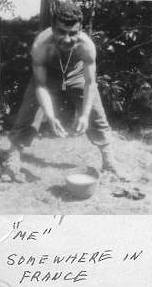 At
this time Rcn. Co. was attached to CCA and the 1st platoon was given their
first mission, we were to lead the column on the main axis of their march.
The platoon was hastily oriented, and at 1300 hrs. AUG. 1st 1944 we moved
out from AVARANCHES, this being the first time the platoon was leading
a column with nothing in front of it except possibly enemy. We were quite
cautious at first choosing to work the point by walking, the remainder
of the platoon following slowly in the vehicles. Every thing went well
for awhile, it was after about two hours of travelling that the platoon
had stopped momentarily to obtain information from a French civilian, at
this time Pvt. Smith who was looking down the road, called out that there
was a German soldier coming up the road, sure enough the enemy soldier
was walking toward us, he was unarmed, he was covered and told to take
off his equipment and then sent back to the rear. Nothing further happened
until upon arriving at a small village, some more prisoners were encountered
and a small engagement between some german troops and F.F.I. personnel.
Upon entering ANTRAIN the platoon bivouaced for the night. The following
morning August 2nd, at 0600 hours, P.F.C. Kelly who was on guard at the
time, glanced over the hedgerow, and to his amazement counted eight German
soldiers sneaking along the hedgerow, Kelly turned to alert the platoon
and while doing so, a German Soldier raised up over the hedgerow brandishing
a potato-masher, P.F.C. Erlick who had his eye on the hedgerow, promptly
shot the German, seriously wounding him, the First Platoon's first victim.
Later in the morning the 1st platoon was given the mission of taking a
route on the main body's left flank, a platoon of infantry accompanied
them, the day was uneventful for the First platoon, we passed through one
of the largest cities on the peninsula we were working on, COMBOURG. That
evening a roadblock was encountered and all of Rcn. Co. was pinned down
for quite some by sniper fire, 1st platoon bivuoaced at this point. The
third day AUG. 3rd the 1st platoon was placed behind the 86th Rcn., and
they merely followed the column until reaching MAURON where the column
met heavy resistance and was held up for seven hours while artillery shelled
the town, and the infantry moved in and took the town. When the town fell
and the column moved through, the 1st platoon was given the mission of
outposting the left flank while the column pulled into their bivuoac area,
the platoon did this and was later called in to Rcn. Co.'s area.
At
this time Rcn. Co. was attached to CCA and the 1st platoon was given their
first mission, we were to lead the column on the main axis of their march.
The platoon was hastily oriented, and at 1300 hrs. AUG. 1st 1944 we moved
out from AVARANCHES, this being the first time the platoon was leading
a column with nothing in front of it except possibly enemy. We were quite
cautious at first choosing to work the point by walking, the remainder
of the platoon following slowly in the vehicles. Every thing went well
for awhile, it was after about two hours of travelling that the platoon
had stopped momentarily to obtain information from a French civilian, at
this time Pvt. Smith who was looking down the road, called out that there
was a German soldier coming up the road, sure enough the enemy soldier
was walking toward us, he was unarmed, he was covered and told to take
off his equipment and then sent back to the rear. Nothing further happened
until upon arriving at a small village, some more prisoners were encountered
and a small engagement between some german troops and F.F.I. personnel.
Upon entering ANTRAIN the platoon bivouaced for the night. The following
morning August 2nd, at 0600 hours, P.F.C. Kelly who was on guard at the
time, glanced over the hedgerow, and to his amazement counted eight German
soldiers sneaking along the hedgerow, Kelly turned to alert the platoon
and while doing so, a German Soldier raised up over the hedgerow brandishing
a potato-masher, P.F.C. Erlick who had his eye on the hedgerow, promptly
shot the German, seriously wounding him, the First Platoon's first victim.
Later in the morning the 1st platoon was given the mission of taking a
route on the main body's left flank, a platoon of infantry accompanied
them, the day was uneventful for the First platoon, we passed through one
of the largest cities on the peninsula we were working on, COMBOURG. That
evening a roadblock was encountered and all of Rcn. Co. was pinned down
for quite some by sniper fire, 1st platoon bivuoaced at this point. The
third day AUG. 3rd the 1st platoon was placed behind the 86th Rcn., and
they merely followed the column until reaching MAURON where the column
met heavy resistance and was held up for seven hours while artillery shelled
the town, and the infantry moved in and took the town. When the town fell
and the column moved through, the 1st platoon was given the mission of
outposting the left flank while the column pulled into their bivuoac area,
the platoon did this and was later called in to Rcn. Co.'s area.
The following morning AUG. 4th the 1st platoon took the lead, and accompanied by the 2nd platoon, were given the mission of backtracking a few miles and swinging up towards DINAN, a large city that had been by-passed. It was a fast ride and uneventful until, upon reaching the entrance to BRONS a roadblock was encountered. After knocking the roadblock out with their 37 mm. guns, the 1st platoon and 2nd platoon advanced into BROONS. It was here that the 1st platoon rescued three American pilots who had been shot down and hiding from the Germans for 105 days. At this point the mission was changed, and with the 1st platoon again in the lead, we raced back over the route travelled that morning. We came to, and passed through the town of PONTIVY, we received a wonderful welcome here from the civilians, bread and butter, cognac, champagne, wine and kisses were handed and given to the men as they passed through the town. The First platoon experienced much of this happy welcoming from the civilians, as very often we were the first Americans they saw, and the first to liberate them. Very often the vehicles were so bedecked with flowers after going through a town. that the men had to throw away all flowers after leaving the town, as they did not help camouflage any.
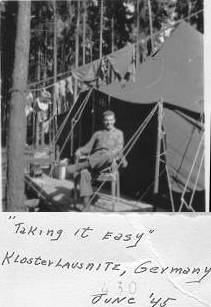 The
column proceeded from PONTIVY to GOURIN, arriving late that evening, just
after clearing the town of GOURIN, arriving late that evening, just after
clearing the town of GOURIN S Sgt. Fick who was riding in the point jeep
of the 1st platoon at the time noticed some men in the ditch directly in
front of him. Fick had the jeep stop and was instantly fired upon by a
machine gun. S Sgt. Fick and the occupants of his jeep and the one following
immediately took cover. Lt. Boggs M 8 which was directly behind the jeeps
opened fire at once, and during this covering fire the jeeps were backed
up, all vehicles to the rear opened fire on the flanks, but only for a
short time as no fire was returned. The platoon and the column halted at
this point until daylight.
The
column proceeded from PONTIVY to GOURIN, arriving late that evening, just
after clearing the town of GOURIN, arriving late that evening, just after
clearing the town of GOURIN S Sgt. Fick who was riding in the point jeep
of the 1st platoon at the time noticed some men in the ditch directly in
front of him. Fick had the jeep stop and was instantly fired upon by a
machine gun. S Sgt. Fick and the occupants of his jeep and the one following
immediately took cover. Lt. Boggs M 8 which was directly behind the jeeps
opened fire at once, and during this covering fire the jeeps were backed
up, all vehicles to the rear opened fire on the flanks, but only for a
short time as no fire was returned. The platoon and the column halted at
this point until daylight.
As soon as it was light the column again proceeded, things were quiet until reaching the town of POULLAOUEN, it was here that the column halted for a few minutes, then with the 1st platoon leading followed by the 4th platoon we proceeded through the town, and clearing the town proceeded around a bend, up a gradual slope, on a road with a high hill on one side and a small ravine and rocky hill on the other side. Sgt. Civarra who was in the point jeep at this time noticed that about half way up the slope a friendly column of the 86th Rcn. was halted facing the opposite way that the platoon was moving, upon reaching the point vehicle of the halted column Civarra had the driver Pfc. Joseph stop, almost immediately the column was fired upon from both sides of the road. The personnel of the jeeps immediately took cover except for the machine gunners who began firing. Pvt. Purser who was riding on the back of the Plat. Leader's M 8, scrambled off to take cover, and was hit by machine gun fire which was coming from a small cut in the embankment directly to the left of the M 8. The vehicle dropped back, and S/Sgt. Fick had his M 8 pull up to the spot; T/5 Reed J. knocked out the machine gun with his 37 mm. gun. Pvt. Smith in the meantime worked his way up to Pvt. Purser and with the aid of Pvt. Slack and Pfc. Hildebrant they put Purser on a jeep and moved him to a house nearby.
Pvt. Purser had been hit in the thigh, the bullet going through the leg. Pvt. Smith was also slightly wounded in the leg by a piece of shrapnel while going to the aid of Purser. Purser was treated by an aid man and taken to the rear. All during this time there was considerable firing going on. When the battle was over the platoon had expended much of its ammunition. The Platoon remained in its position until the column again proceeded, this time the second Platoon leading with the First Platoon following them. The rest of the day was uneventful. Late that evening the column stopped just short of HUELGOAT. The Second Platoon having learned from a French source of information that considerable enemy forces were near-by. A Bivouac area was picked for the Platoon. P.F.C. Erlick was the first man with his Jeep into the area. He drove up to the far corner, and in the moonlight saw some enemy soldiers dug into the hedgerow. He backed out of the area and a new area was found. The men dug in and after getting the guard set up, prepared to sleep. During the early morning, while still dark, an enemy patrol was in the vicinity. Grenades were used and one German Officer was killed.
At daylight August 6th, the column proceeded through the town of HUELGOAT, First Platoon following the Third Platoon. The column was held up a short time in HUELGOAT, being pinned down by mortar fire. After a short halt the column proceeded again. Upon reaching PLUILEE, the First Platoon was given the mission of reconnoitering the left flank of the main axis of march for five or six miles. This mission accomplished, the Platoon later resumed its position in the column. In the vicinity of PLEYBER a blown bridge was encountered. The First Platoon was given the mission of backtracking and reconnoitering the left flank of the main axis of march for five or fix miles. This mission accomplished, the Platoon later resumed its position in the column. In the vicinity of PLEIBER a blown bridge was encountered. The First Platoon was given the mission of back tracking and reconnoitering a road to the right for a possible route for the column. It was learned that the Second Platoon had found a route, so the First Platoon returned to the column. Upon reaching the crossroads to the new route the column halted for a short time and during this time Pvt. Smith was sent to the rear for treatment of the shrapnel wound, received August 5th. The column proceeded and traveled all that night.
Early in the morning August 7th the column arrived at BODILIS. Just on the other side of town there was a long halt, when it was learned there was a rocket projector and some large guns ahead. Most of the forenoon was spent at this point while friendly planes strafed enemy installations. The column was again ordered to move, this time the First Platoon leading. Late in the afternoon the column was again halted when the First Platoon and other leading elements were pinned down by air bursts directly over the road being travelled. At this time a heavy fog was settling and it was beginning to get dark. The column moved forward to bivouac areas, and the First Platoon was given the mission of setting up an outpost about a mile ahead. Platoon moved into position in the early morning hours of AUG. 8th. At this time we were from 5 to 7 miles from the Division's objective - the city and port of BREST.
Shortly after daylight Rcn. Co. minus the First & Second platoons was very heavily shelled by mortar and "88" fire. First Platoon remained in position until late in the afternoon at which time they moved back a short distance to a new area with Rcn. Co. The following morning the First Platoon was sent to the vicinity of PLOVIEN where a new area was picked for Rcn. Co. AUG. 10th, early in the afternoon the First Platoon was given the mission of proceeding to LENNILUS where they were to act as a covering force for one vehicle which was to proceed into town with an interpreter under a white flag to propose an ultimatum for the surrender of the enemy forces in town, and in coast defenses just outside of town. T/5 Metroz of the Second Platoon and an interpreter using Pfc. Erlick's jeep drove into town, after quite some time the Germans agreed to surrender and the First Platoon moved in to take the prisoners. The enemy numbered about 125 men. They were loaded on the vehicles and brought to Rcn. Co. area; they were put in the center of a field where they spent the night under guard by personnel of Rcn. Co.
The following
morning AUG. 11th, the 1st platoon returned to the place where the prisoners
were taken. The beach fortifications were inspected and many useful articles
and weapons salvaged. The First platoon set up a road block at this point
while the Second platoon effected the surrender of more enemy troops in
other fortifications farther ahead.
AUG. 13th,
the First platoon was given the mission of leading the column back over
the route taken as far as GOURIN, from there we cut off towards LORIENT
another large city and port. A bivouac area was picked just short of ARZANO.
Early evening of AUG. 14th, platoon was given the mission of moving to
PONTSCORFF and relieve the elements who were outposting the town; one platoon
of TD's accompanied the First platoon. The following morning the platoon
was relieved and moved back to Rcn. Co. area. The next day AUG. 16th Rcn.
Co. moved to a new area - in the other side of ARZANO. During our stay
in this area the First platoon made patrol missions, and contacted F.F.I.
outposts on the QUIMPERLE-CLOHARS and QUIMPERLE-LORIENT road. On one of
these patrols Pvt. Jacobsen was sent back to Rcn. Co. with messages and
overlays. Upon returning he found the platoon had moved, while looking
for the platoon or returning to the Co. area, Jacobsen had an accident
with the motorcycle and it left the road on a turn. He was picked up by
French civilians who took him to a hospital in QUIMPERLE. Pvt. Jacobsen
died from these injuries the following morning. Also during our time at
this area we were visited by the div C.O. Major Gen Grow who awarded Silver
Stars & Bronze Stars to a few members of Rcn Co.
AUG. 20 Rcn Co again moved this time to the vicinity of QUIMPERLE. From QUIMPERLE the First platoon were given patrolling and reconnaissance missions nearly every day. The platoon did much patrolling, kept steady contact with FFI outposts, and sent back to Hqs many useful overlays and considerable information. Quite often personnel of the platoon made dismounted patrols & also located good OPs for our friendly artillery observers. On some of these patrols the platoon was under shellfire from enemy forces on the opposite side of the river. It was one of these days that Sgt Golden who with the 3rd platoon accompanied the 1st platoon on a mission was killed when a shell burst in a small tree which he was under at the time. These missions of patrolling were on the QUIMPERLE-CLOHARS road and the QUIMPERLELEPOULDU road.
On Aug 29 platoon was alerted and driving in column with Rcn. Co. headed East, through PLOUAY, BUBRY, BAUD and VANNES, a bivuoac area was picked just east of VANNES. The following morning Aug 30 platoon again moved out with Rcn Co until reaching REDON. Here the first platoon took the lead and was given the mission of leading the column to ANGERS from REDON. The platoon proceeded driving quite fast through HUEMINE, CHATEAUBREANT, POUANCE, SERGE to ANGERS. Platoon stopped in ANGERS to await further orders and then proceeded through ANGERS to the vicinity of BAUGES where a bivouac area was found. No enemy had been contacted, the road being clear North of the Loire River. Following morning Aug. 31 1st platoon was given the mission of patrolling the route from BAUGE to CHATEAU la VALLIER with south to CINQ-MARS and also contacting friendly forces who were outposting north bank of the Loire river, considerable enemy being all along the southern sector. Platoon proceeded on this mission and made contact with friendly forces. At CINQ-MARS there was a large tunnel which was a matter of miles long and had a tremendous amount of foodstuffs, rations, coffee and liquor stored in it by the Germans. Friendly troops were salvaging much of this and 1st platoon was told to take out as much as they could for Rcn. Co. Platoon proceeded to do this and had just started when orders were changed and no more rations could be taken from the tunnel. Platoon was called back and again the column proceeded through TOURS, BLOIS. BEAUGENC, and ORLEANS.
A bivouac area was picked on the outskirts of ORLEANS. Following morning Sept. 1st column proceeded through ORLEANS, and CHATAMEUF to a bivouac area in the vicinity of LEO BORDES. Platoon remained here until Sept. 3rd when Rcn. Co. moved to a new area at a fork in the highway to Glen and BRIARE. Platoon remained with RCN Co in this area until Sept. 6th when they were given the mission of outposting the town of TOUCY and patrolling and gaining information from FFI and other American patrols and CPs in the surrounding area. Platoon arrived in TOUCY and set up two outposts, 1st section on one road, 2nd section on another road. Each day a vehicle and crew were sent up to AUXERRE where information was available from FFI sources. Trips were also made from TOUCY to AUXERRE to JOICNY; contact was made with the 35 DIV. 1st platoon sent numerous messages and overlays from TOUCY regarding enemy information. Early in the morning Sept. 10 platoon was alerted and moved from TOUCY through ST. FARGEAU, LAVAU and BONNY, here the platoon headed south through NEUVY MAYENNES and COSNE. It was at COSNE that no contact was made with any friendly troops and the platoon went back over the same route to BONNY, where they continued to BRIERE and to Rcn. Co. bivouac area, after first stopped in GIEN for a shower. Sept. 12 Rcn. Co. moved from the area, north to MONTARGIS and then east through COURTENAY, SENS and TROYS. A short ways east of TROYES a bivouac area was picked. Sept. 14 platoon was given the mission of going to TANLEY, establishing an outpost, and continue patrols and contacting friendly patrols the same as they had done at TOUCEY.
Platoon proceeded to TANLAY by way of CHAORCE, COUSSEGRY, TONNERRE and TANLEY. Outpost was established and trips were made to AUXERRE, and also the road was patrolled from TANLAY to MONTBARD, VITTAUX, AVALLON, CHABLIS, TANLAY, once again platoon sent numerous messages and overlays back to Co. Hqs. While at TANLAY Pvt. Nichols who was standing guard at approximately 0130 Hrs. Sept. 16, was shot at, and wounded in the leg.
Immediate search was made by the platoon, but no one was found. First aid was administered and Pfc. Hildbrante with Pvt. Slack drove Nichols to a French Hospital at TROYES. Sept. 17 platoon was alerted and moved back to the area where they had left Rcn. Co. Upon arriving it was discovered the company had already left. Platoon then proceeded following a column which was going the same way. Platoon arrived in Rcn. Co. area near NEUFCHATEAU by way of BAR-s AUBE, BLAISE, BOLOGNE, ANDELOT, RIMAUCORUT, NEUFCHATEAU. Platoon went into bivouac for the night. Following morning Sept. 18, platoon again moved out with Rcn. Co. through AUTREVILLE COLOMBEY, TOUL and NANCY, east of NANCY toward LUNVILLE. Platoon pulled in an area just east and south of NANCY for the night, here the platoon and Rcn. Co. had a ringside view of tanks and infantry assaulting a hill directly in front of them.
The next morning Sept. 19 platoon again moved out towards LUNEVILLE and arriving in the town of MAIXE were halted for quite some time awaiting further orders. About noon the platoon moved to an area just outside of MAIXE, just as everyone was at the kitchen preparing to eat, the enemy started shelling the area near the kitchen. The men dispersed, and when shelling continued Rcn. Co. moved across country to a new area on the side of a hill. The platoon remained in this area with Rcn. Co. until Sept. 22 at which time Rcn. Co., with the first platoon leading moved north through MAIXE and to some woods in the vicinity of ARRACOURT. Late that afternoon the first platoon was given the mission of outposting the edge of the woods facing the enemy. The platoon immediately set up positions in the edge of the woods and had the fields approaching the woods well covered.
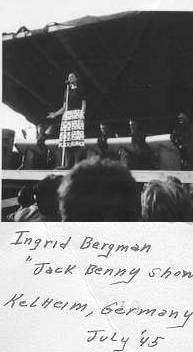 The
following morning Sept. 23 the platoon moved out along with CCA who was
attacking the town of ARRACOURT. The 1st platoon was following in column
behind the platoon of destroyers of the 603. After traveling a short distance
from the bivouac area the column halted for a few moments. At this time
members of the 1st platoon spotted an enemy vehicle traveling on a road
to the left of the column about 600 yds away. Platoon's M8s immediately
started to traverse the 37 mm guns toward the vehicle, but one of the destroyers
directly in front of the platoon also spotted the vehicle, and having an
electrically powered turret they had the vehicle in their sights much quicker.
They fired and scored a direct hit; the car burst into flames, and the
1st platoon open up on three enemy soldiers who had leapt from the vehicle
a moment before the shell hit. Column proceeded another 100 yds. and was
halted again; at this time the platoon was under heavy enemy mortar fire
and shellfire. S/Sgt. Fick looking through a telescope observed a German
soldier well dug in and acting as a F.O. T/5 Reed J. fired two or three
rounds of 37mm. at him, but failed to knock him out. The column again moved
forward until reaching a bridge which was found to be too weak to hold
the vehicles. It was bypassed and the column again proceeded along the
road. By the end of the day CCA had succeeded in taking ARRACOURT and also
a large ammunition dump in the vicinity of ARMACOURT which was also taken.
1st platoon went into bivouac with Rcn. Co. in the vicinity of AGINCOURT.
The
following morning Sept. 23 the platoon moved out along with CCA who was
attacking the town of ARRACOURT. The 1st platoon was following in column
behind the platoon of destroyers of the 603. After traveling a short distance
from the bivouac area the column halted for a few moments. At this time
members of the 1st platoon spotted an enemy vehicle traveling on a road
to the left of the column about 600 yds away. Platoon's M8s immediately
started to traverse the 37 mm guns toward the vehicle, but one of the destroyers
directly in front of the platoon also spotted the vehicle, and having an
electrically powered turret they had the vehicle in their sights much quicker.
They fired and scored a direct hit; the car burst into flames, and the
1st platoon open up on three enemy soldiers who had leapt from the vehicle
a moment before the shell hit. Column proceeded another 100 yds. and was
halted again; at this time the platoon was under heavy enemy mortar fire
and shellfire. S/Sgt. Fick looking through a telescope observed a German
soldier well dug in and acting as a F.O. T/5 Reed J. fired two or three
rounds of 37mm. at him, but failed to knock him out. The column again moved
forward until reaching a bridge which was found to be too weak to hold
the vehicles. It was bypassed and the column again proceeded along the
road. By the end of the day CCA had succeeded in taking ARRACOURT and also
a large ammunition dump in the vicinity of ARMACOURT which was also taken.
1st platoon went into bivouac with Rcn. Co. in the vicinity of AGINCOURT.
The following morning Sept. 24th platoon was given the mission of patrolling the Road from ARMACOURT through ALLIANCOURT and back to the area; this was done. Upon returning the 1st platoon was given the mission of the LEYRALLIANCOURT road. The platoon moved into position late that afternoon. The next morning Sept. 25th the platoon moved forward about 800 yds. to the next ridge from where they could get a better view of the terrain ahead, and could also cover more area with the guns. Late that afternoon the platoon noticed infantry troops coming towards them about a 1000 yds. away; upon looking through the field glasses it was learned they were enemy troops. Lt. Boggs immediately jumped in Pfc. Hildebrant's jeep and sped back to notify and bring back an artillery observer. In the meantime the platoon had all their guns trained on the enemy who were still advancing in waves, and dispersed. Sgt. Civarra walked back about 400 yds. to where the Hqs. platoon of Rcn. Co. were, and warned them and also told them to watch their flanks.
At this time the first wave of enemy troops were about 500 or 600 yds. from the platoon's position, S/Sgt. Fick not wanting to fire until they were closer. The enemy evidently spotting the platoons position started veering to their right towards some woods, and as this would take them further out of range, the 1st platoon immediately opened fire with all machine guns, 37mm, and small arms. The enemy hit the ground and returned some fire, but they were well pinned down and suffering many casualties from the 1st platoons guns. A friendly artillery observer had also arrived and was directing a battery of artillery who were firing air bursts directly over the enemy. Friendly light tanks also arrived and assisted the 1st platoon. The tanks then proceeded forward to where the first wave had fallen. A few Germans who had taken cover in a large ditch surrendered; some were stubborn and kept firing at the tanks until the tanks' guns silenced them. S/Sgt. Fick also went down with his M8, and while there discovered that the tires on his vehicle had been flattened during the battle. 29 prisoners were taken, and 15 wounded prisoners, (there were more wounded, but by this time it was very dark, and the M8 and tanks were in a bad position if the enemy started another attack), there were also a large number of dead enemy soldiers.
There were
no casualties among the 1st platoon or other friendly troops except for
a slight wound on the chin that Pfc. Erlick received from a piece of shrapnel.
1st platoon moved back about a 1/2 mile and again took up positions. The
next day Sept. 26th, friendly infantry moved into position in front of
the platoon. Sept. 27th enemy mortar fire landed in the area at intervals.
Early in the evening the platoon was relieved by the 3rd platoon and moved
back in an orchard just back of LEYR. When the platoon had pulled in, Pfc.
Martinez who had gone for some water noticed a group of six or seven people
walking near the edge of the woods on a hill near the platoons position;
he ran back and notified the platoon. S/Sgt. Fick, Sgt. Civarra, and Tec
5 Pleasant went to investigate and learned that they were civilians. The
next morning Sept. 28th the platoon moved out with Rcn. Co. to DOMMARTEMONT
just on the outskirts of NANCY. The platoon was billeted in a schoolhouse
and were quite happy to be under a roof for the first time since landing
in France. Sept. 31st platoon was alerted and moved out in the early evening,
moving northeast from NANCY to an area in the woods in the vicinity of
GREMECY. Platoon was attached to "A Co.".
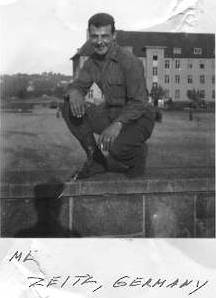 The
following morning Oct. 1st an attack was made to take the town of GREMECY.
1st platoon moved with the destroyers staying on their left flank, the
objective for the destroyers being a small hill overlooking GREMECY. Enemy
mortar fire and shellfire was very heavy and progress was slow. Upon reaching
the objective enemy mortar fire became very heavy and getting quite accurate.
The platoon and A Co. drew back a few hundred yds. 1st platoon moved to
an area just off the road to GREMECY. Toward evening S/Sgt. Fick with the
2nd section moved up the road about half a mile and were given the mission
of staying there to cover other units pulling out of their areas. Around
midnight the 2nd section joined the remainder of the platoon, and along
with A Co. the platoon moved back about a mile to a bivouac area. The following
morning Oct. 2nd the platoon moved back to DOMMARTEMONT, the platoon remained
here with Rcn. Co. The men were able to take showers, visit NANCY, see
movies, and obtain clothes and equipment, first echelon was performed on
the vehicles. Rcn. Co. remained here until Nov. 7th when the 1st platoon
was alerted to move at 1230 hrs. and join A Co. in the vicinity of LEYR.
The
following morning Oct. 1st an attack was made to take the town of GREMECY.
1st platoon moved with the destroyers staying on their left flank, the
objective for the destroyers being a small hill overlooking GREMECY. Enemy
mortar fire and shellfire was very heavy and progress was slow. Upon reaching
the objective enemy mortar fire became very heavy and getting quite accurate.
The platoon and A Co. drew back a few hundred yds. 1st platoon moved to
an area just off the road to GREMECY. Toward evening S/Sgt. Fick with the
2nd section moved up the road about half a mile and were given the mission
of staying there to cover other units pulling out of their areas. Around
midnight the 2nd section joined the remainder of the platoon, and along
with A Co. the platoon moved back about a mile to a bivouac area. The following
morning Oct. 2nd the platoon moved back to DOMMARTEMONT, the platoon remained
here with Rcn. Co. The men were able to take showers, visit NANCY, see
movies, and obtain clothes and equipment, first echelon was performed on
the vehicles. Rcn. Co. remained here until Nov. 7th when the 1st platoon
was alerted to move at 1230 hrs. and join A Co. in the vicinity of LEYR.
Platoon alerted to move 0800, Monday, 6 November 1944. Departed Dommartemont at 1200 hours and entered bivouac area of Company "A" 603 TD Bn., approximately 2 1/2 miles southeast of LEYR. That night the rain was coming down in torrents and by morning the water was rising all around us in the field. That evening, 7 Nov. 1944 at 1700, the platoon was alerted to move out to an assembly area at 0645, 8 Nov. During this time we were attached directly to Task Force Forrest (CCB). With water and mud surrounding us the platoon decided to drive the vehicles out on higher ground. A few hours of constructing a new road and pushing the vehicles, the vehicles were all on high ground and all the men were soaking wet and muddy. The next day Wednesday, the 8th, we proceeded to an assembly area for the Task Force 1 1/2 mile east of ATTON, by way of LEYR MONTENOY, FAULX, MALLELOY, CUSTINES, MILLERY, AUTREVILLE, and north along the Moselle river to ATTON. Thursday, Nov. 9 the platoon was held in reserve at the same location with the remainder of the Task Force. Friday morning, Nov. 10th, we moved out under blackout conditions from ATTON to 1 1/2 mile north of ERLY by way of PORT-SUR-SEILLE EPLY.
Saturday, Nov. 11, we were alerted to move forward but after moving on the road, the move was cancelled and the platoon was held in reserve at the same area. The following morning we moved under blackout conditions to our first mission at HAN-SUR-NIED, where Task Force Forest relieved another Task Force of "CCA". Our route of march from EPLY area, north to LOUVIGNY east thru VIGNY, BUCHY, LUPPY, BECHY. The platoon was the leading unit for the Task Force. We were halted approximately 300 yards from the bridge at HAN-SUR-NIED to reorganize into an attack formation. During this time we were under heavy artillery fire causing us to disperse the vehicles and men in the field. Approximately 1230 hours the attacking force crossed the river and started the attack. At 1400 we crossed the river and dispersed in a field directly east of the town where we were under continuous artillery fire. Several of the rounds hit within 20 yards of the vehicles.
The town of HERNY was cleared of enemy installations and then we went into bivouac 500 yards west of HERNY. Securing the left flank of the Task Force we were under artillery fire throughout the night. The following morning 13 Nov. 1944, we left the bivouac area at 0915 attached to the Task Force Headquarters. Making very little progress towards MANY, the column was halted because of stiff opposition east of MANY. The platoon leaders (Lt. Boggs) vehicle was halted approximately 100 yards west of MANY and the remaining column vehicles halted at a good interval.
Lt. Bogge sent Sgt. Civarra forward with a jeep to contact the 69th Tank Reconnaissance. As Sgt. Civarra, Pfc. Joseph, and Pvt. Irwin entered MANY a large mortar shell hit and exploded in front of the jeep. The two front tires were ruptured and several holes were blown in the radiator by shrapnel. The water can and personal equipment were badly damaged by shrapnel. Members riding in the jeep were badly shaken up, however no casualties were reported. After losing the jeep, Sgt. Civarra placed his equipment on Pfc. Erlick's jeep and Pfc. Lucero stayed with Pfc. Joseph and Pvt Irwin, Sgt. transporting the jeep back to the maintenance crew of Headquarters platoon. The column was under intense mortar fire, shrapnel landing on both sides of the road, barely missing the vehicle. At 1330 hours another heavy barrage of mortar fire hit our column, one projectile hit the shoulder of the road only 10 feet from a jeep. Pvt. McClure happened to be standing close to his jeep when this incident occured. However the flying shrapnel did not touch him At this time S/Sgt. Fick and some of the boys decided something had to be done and so they decided the best way to stop the mortar fire was to locate the mortar. Believing the wooded area located 300 yards north of the road was clear of enemy installations, Pvt. Smith and platoon Sgt. proceeded along the edge of the woods towards the direction of the mortar fire. Upon reaching the far corner two wounded Germans were seen about 200 yards from the woods. Talking them into surrender, the patrol was amazed to see German soldiers come marching out of the woods with their hands flung high in the air. At this point the prisoners were turned over to an Infantry antitank gun crew and S/Sgt. Fick and Pvt. Smith checked all the fox holes in that part of the wooded area. An additional prisoner was forced out of the foxhole bringing the total amount of prisoners up to 37.
At 1530,
we dispersed 1/4 mile southeast of MANY, at which time a battery of German
150's zeroed in on
our position.
A foot patrol of 5 men consisting of S/Sgt. Fick, Tec 5 Pleasant, Reed,
Pfc. Kelly, Pvt. Reid were sent out to reconnoiter the next ridge and try
to locate the gun positions. At 1630 the artillery fire increased and Lt.
Boggs decided to move the vehicles to a new position, at which time Pfc.
Erlick got into his jeep and started to move it when an artillery shell
hit the right wheel, tossing him to the ground.
Sgt. Civarra
who was guiding him to the new position heard the shell and jumped into
a fox hole close to Erlick. A small piece of shrapnel lodged in his toe
and Erlick was badly shaken. The jeep and equipment were almost completely
destroyed. At dark the platoon moved into a bivouac area 1/2 mile west
of THICOURT and setting up a security on the right flank of Headquarters
CP section. At dawn Nov. 14th, heavy enemy artillery fire landed in the
area and during the course of the day periodic barrages continued. Sgt.
Civarra, Pfc's Erlick, Hildebrandt, and Pvt. Reid were sent to the CP at
Luppy to obtain two scout jeeps that were damaged the previous day. The
same day they returned to THICOURT where the platoon was located. That
evening, artillery fire was landing between the vehicles, and a small piece
of shrapnel hit Pvt. Irwin at which time he had the wound treated and returned
to duty. The following day Lt. Boggs was hospitalized for a serious case
of trench foot and platoon Sgt. Fick took charge of the 1st platoon.
On Nov.
16th, the platoon was under enemy artillery fire after the Task Force pushed
off for the attack. Pvt. McClain was dispatched to S/Sgt Koski's platoon,
Sgt. of Co. "A" TD platoon, for the purpose of obtaining ammunition and
replacements from Co. "A" CP at Brulange. The platoon stayed intact Friday,
Nov. 17. Both Pfc. Lucero and Pvt. Slack were admitted to the hospital
for trench foot and it was later learned Lucero also had trench mouth.
Pvt. McClain was dispatched to the 2nd platoon of "A" Co. to drive for
their platoon leader. His jeep buckled [broke? -- ed.] down and he was
towed to the company CP the next day.
The morning of the 18th, S/Sgt Hamm brought Pvt. Steele, Meckler, Wodarczyk, Garon, and Tec 5 Jaber out to the platoon to replace Slack, Lucero and McClain. Sgt. Leibli, Hildebrandt and Irwin who returned to the company CP for the purpose of getting their feet treated. At 1530 hours the platoon was relieved from Task Force Forrest and became attached to Company "A" TD who in turn were attached to "CCA" reserve. At 1600, the platoon moved from 1/2 mile west of THICOURT to 500 yards east of BRULANGE. At approximately 0115 that night the Germans started shelling the area with heavy artillery. One shell hit between Hildebrandt's jeep and Smith & Meckler's double fox hole where they were sleeping about 10 yards from the jeep. The shrapnel went through the water can and hit the machine gun jacket mounted on the jeep. It also penetrated through Smith & Meckler's pup tent which was covered over their fox hole and smashed the gas cylinder on Smith's rifle which was lying beside him. On Sunday morning, Nov. 19 at 0900 the platoon became attached to "CCA" supply trains and reported at their Hdqs. in ST. EPRVE.
While at ST. EPRVE Sgt. Leibli, Pfc. Hildebrandt and Pvt. Irwin rejoined the platoon, T/5 Jaber, Pvts. Garon and Wodarczyk returned to the Company. At 1200 hrs. "CCA" moved to a area at BARONVILLE. The platoon was given the mission on the 21st of reconnoitering the roads from BARONVILLE to HARPICH by way of MORCHANGE, and from BARONVILLE to LANDROFF which proved highly successful. The platoon remained with "CCA" supply trains doing reconnaissance work and guarding them. until Dec. 14th at which time the platoon rejoined Rcn. Co. at LEYVILLER. On Dec. 19 the 1st Plt. along with an armored car of Hdqs. platoon made a reconnaissance to Merelbach, Germany, this being the first time any of the men had been on German soil. The following morning we rejoined the Company at LEVILLER. On Dec. 21st S/Sgt. Fick received his commission and became the Plt. Ldr. of the 1st platoon, Sgt. Civarra was promoted to S/Sgt. and was the new Plt. Sgt. T/5 Reed was made Sgt. The platoon was alerted a and moved out with "A" Co. to BETTING. At this time the Germans had started their big counterattack in Belgium and Luxembourg. Dec. 24th, the platoon leading "A" Co. moved out, through St. and [? -- ed.] to METZ. Christmas day was spent at METZ. That evening the platoon was again alerted, and still with "A" Co. we moved north through Luxembourg City to a wooded area near MERSCH, Luxembourg.
 The
following morning the platoon was again attached to "CCA" trains and joined
them at FELS, Luxembourg. From here the 1st platoon reconnoitered and led
the trains to CLOCHIMONT, Belgium, then to HOLLANGE, and BASTOGNE. Platoon
remained in BASTOGNE for about three days and then moved to TRIONE WARDIN,
and finally across the OUR river into Germany. On the 10th of March the
platoon in column with Rcn. Co. moved out, south through Luxembourg METZ.
PONT-MOUSSON, CHATEAU -SALINS, and arrived in Salonnes, France. At this
time the 6th Armrd. Div. was attached to the 7th Army. March 18th we again
moved, this time to an assembly area near SAARE UNION. We remained here
until March 20th at which time Rcn. Co. was given the mission of leading
"CCR". With the First Platoon leading, Rcn. Co. moved out. The drive was
made through ZWEIRRUCKEN. and generally northeast near KAISERSLAUTERN and
on to the vicinity of EISENBERG, which was just short of the Rhine river.
Many prisoners were captured. and very much enemy equipment destroyed in
the drive, which cleaned the SAAR BASIN of the enemy. March 25th the platoon
with Rcn. Co. moved out. and in the afternoon crossed the Rhine river at
OPPENHEIM. Once again the 6th Armored Div. was back with the 3rd Army.
The
following morning the platoon was again attached to "CCA" trains and joined
them at FELS, Luxembourg. From here the 1st platoon reconnoitered and led
the trains to CLOCHIMONT, Belgium, then to HOLLANGE, and BASTOGNE. Platoon
remained in BASTOGNE for about three days and then moved to TRIONE WARDIN,
and finally across the OUR river into Germany. On the 10th of March the
platoon in column with Rcn. Co. moved out, south through Luxembourg METZ.
PONT-MOUSSON, CHATEAU -SALINS, and arrived in Salonnes, France. At this
time the 6th Armrd. Div. was attached to the 7th Army. March 18th we again
moved, this time to an assembly area near SAARE UNION. We remained here
until March 20th at which time Rcn. Co. was given the mission of leading
"CCR". With the First Platoon leading, Rcn. Co. moved out. The drive was
made through ZWEIRRUCKEN. and generally northeast near KAISERSLAUTERN and
on to the vicinity of EISENBERG, which was just short of the Rhine river.
Many prisoners were captured. and very much enemy equipment destroyed in
the drive, which cleaned the SAAR BASIN of the enemy. March 25th the platoon
with Rcn. Co. moved out. and in the afternoon crossed the Rhine river at
OPPENHEIM. Once again the 6th Armored Div. was back with the 3rd Army.
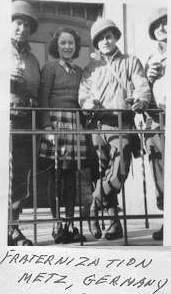 We
moved to an area on the east side of the Rhine for the night. During the
night German planes made an effort to destroy the bridge. They dropped
many flares and strafed and bombed -- but were unsuccessful. March 26th
the platoon was alerted and moved out through GROSS GERAU, NORFELDEN and
to a small clearing in the woods just short of FRANKFURT. Platoon remained
here during the night. March 27th early in the morning the 2nd section
jeeps with Lt. Fick made a route reconnaissance to FRANKFURT to locate
any bridges across the Main river. They went through part of town not yet
taken and captured two German soldiers. March 28th the platoon moved out,
leading the column through NEUISENPURG, OFFENBACH and across the Main river
at HOCHSTADT. At this point a friendly unit was contacted. Lt. Fick with
two jeeps doubled the column to locate another bridge over the next river.
In the meantime the Task Force with the 1st Platoon still in the lead turned
right on another route through NACHENBAUCEN and met the same friendly column
again. Task Force C.O. decided to spend the night in this area. 1st platoon
was given the mission of guarding the bridge at NORFELDEN. S/Sgt. Civarra
led the remainder of the platoon down to the bridge where they joined Lt.
Fick. That night while on guard Pfc. McClure & Reid M. captured a enemy
soldier about 0100 hrs. who was trying to cross the bridge. At 0500 March
29th the platoon was alerted, the 3rd platoon took the lead and the 1st
platoon pulled in column behind them. We passed through HUDESHEIM, KAICHEN,
and to some woods near FLORSTAT, at this point the 3rd platoon took some
prisoners and the Task Force had to change directions for the purpose of
operating on a better road. 1st platoon took the lead and proceeded to
move; hadn't gone far when some enemy soldiers were spotted behind a peat
pile. Platoon opened fire on them but continued on their mission leaving
them to be taken care of by the rest of the column. Platoon moved on through
GELTNEAU, HUNGEN, INHEIDEN, LANGSDORF and across the Superhighway to STEINBACH
in the vicinity of GEISSEN. While here Rcn. Co. was released from "CCA"
and attached to "CCB".
We
moved to an area on the east side of the Rhine for the night. During the
night German planes made an effort to destroy the bridge. They dropped
many flares and strafed and bombed -- but were unsuccessful. March 26th
the platoon was alerted and moved out through GROSS GERAU, NORFELDEN and
to a small clearing in the woods just short of FRANKFURT. Platoon remained
here during the night. March 27th early in the morning the 2nd section
jeeps with Lt. Fick made a route reconnaissance to FRANKFURT to locate
any bridges across the Main river. They went through part of town not yet
taken and captured two German soldiers. March 28th the platoon moved out,
leading the column through NEUISENPURG, OFFENBACH and across the Main river
at HOCHSTADT. At this point a friendly unit was contacted. Lt. Fick with
two jeeps doubled the column to locate another bridge over the next river.
In the meantime the Task Force with the 1st Platoon still in the lead turned
right on another route through NACHENBAUCEN and met the same friendly column
again. Task Force C.O. decided to spend the night in this area. 1st platoon
was given the mission of guarding the bridge at NORFELDEN. S/Sgt. Civarra
led the remainder of the platoon down to the bridge where they joined Lt.
Fick. That night while on guard Pfc. McClure & Reid M. captured a enemy
soldier about 0100 hrs. who was trying to cross the bridge. At 0500 March
29th the platoon was alerted, the 3rd platoon took the lead and the 1st
platoon pulled in column behind them. We passed through HUDESHEIM, KAICHEN,
and to some woods near FLORSTAT, at this point the 3rd platoon took some
prisoners and the Task Force had to change directions for the purpose of
operating on a better road. 1st platoon took the lead and proceeded to
move; hadn't gone far when some enemy soldiers were spotted behind a peat
pile. Platoon opened fire on them but continued on their mission leaving
them to be taken care of by the rest of the column. Platoon moved on through
GELTNEAU, HUNGEN, INHEIDEN, LANGSDORF and across the Superhighway to STEINBACH
in the vicinity of GEISSEN. While here Rcn. Co. was released from "CCA"
and attached to "CCB".
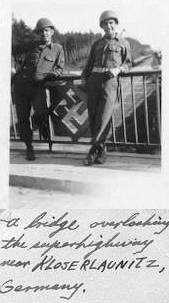 The
Co. was split up and the 1st platoon moved to HATTENROD to join Task Force
"WARD" of "CCB". March 30th platoon started out at 0600 hrs. leading Task
Force Ward. Leaving HATTENROD the platoon proceeded on back roads through
LAUBACH, HORBACH to ROMROD. Here the platoon moved to a Superhighway and
contacted another friendly Task Force which was being held up by enemy
resistance. Maj. Gen. Grow was there and he gave orders for someone to
by-pass the resistance and get on the Superhighway. Platoon immediately
moved out through LIEDERBACH, and after passing through town encountered
some enemy soldiers. After a short fight in which 3 enemy were killed and
2 captured the platoon moved on and encountered another Task Force.
The
Co. was split up and the 1st platoon moved to HATTENROD to join Task Force
"WARD" of "CCB". March 30th platoon started out at 0600 hrs. leading Task
Force Ward. Leaving HATTENROD the platoon proceeded on back roads through
LAUBACH, HORBACH to ROMROD. Here the platoon moved to a Superhighway and
contacted another friendly Task Force which was being held up by enemy
resistance. Maj. Gen. Grow was there and he gave orders for someone to
by-pass the resistance and get on the Superhighway. Platoon immediately
moved out through LIEDERBACH, and after passing through town encountered
some enemy soldiers. After a short fight in which 3 enemy were killed and
2 captured the platoon moved on and encountered another Task Force.
The platoon fell in behind the Task Force until reaching BRAUSCHWEND; here the platoon turned off towards the Superhighway. Lt. Fick sent Sgt. Leibli with his two jeeps along with S/Sgt. Civarra and the armored car to contact a friendly unit which was supposed to be ahead on the highway. After going about 4 miles darkness had fallen so Sgt. Leibli turned back to lead the rest of the column along the route. Civarra with the M-8 and T/5 Hildebrants jeep continued on and contacted the friendly unit as they were pulling into a bivouac area. The column with the remainder of the 1st platoon leading arrived about 0230 hrs. and we went into bivouac in the vicinity of NEIDERBISHEIM. Our speedometers showed an advance of 70 miles that day. At 0700 hrs. March 31st the platoon moved out alone on a reconnaissance mission to locate a possible crossing of the river Fulda at BINSFORTH or NEUMORSCHEN. The platoon didn't and received some artillery fire near a bridge that had been blown. Platoon returned to the area and then moved out again leading a special Task Force who had the mission of getting a bridgehead at NEUMORSCHEN where the bridge had been blown. Upon reaching the town the platoon dispersed the vehicles while the infantry and tanks moved up to the river. The river was not crossed at this point as a friendly unit farther north had established a bridgehead at MALSFED. April 1st at 0700 hrs. platoon moved from NEUMORSCHEN back to WITCHE, and up to MALSFED and crossed the bridge then moved along the river to ALTMORSCHEN and EUBACH. Here an enemy halftrack was observed sitting along the edge of the woods. Pfc. McClure set it afire with his machine gun. Platoon proceeded on to BERGHEIM and upon reaching the outskirts of SPANGENBERG Sgt. Reed noticed and captured three Germans who were laying in a culvert with bazookas intent upon disrupting the column. A friendly column was contacted at this point, and the platoon spent the night in the vicinity of SPANGEBURG.
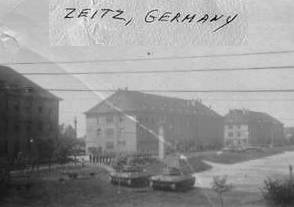 Platoon
was alerted 0600 April 2nd, and at 0700 moved from BERGHEIM trough SPANGENBERG,
LANDEFELD to ELTMANNSEE. While approaching the town it was noticed that
enemy troops were in the vicinity. The two lead jeeps moved into town and
were firing on some enemy troops. In the meantime an enemy assault gun
pulled up to the top of a hill on the platoons right flank and fired two
rounds. Both rounds missed, landing between the armored cars. Platoon then
moved into town to clean out the rest of the German infantry who were approaching
the town on two roads. A tank from the Task Force was sent out after the
assault gun. As he was approaching the hill which was hiding the enemy
gun, the assault gun suddenly pulled up to the top of the hill, and through
this surprise manuever the enemy got the first shot in. The round went
trough the turret of the tank putting its gun out of commission and killing
the gunner and commander. As the tank backed away Pfc. Smith, gunner on
S/Sgt Civarra's armored car who was at this time on the assault guns right
flank -- fired at it with the 37mm gun. The round went through the side
of the assault gun setting it to fire and destroying the crew.
Platoon
was alerted 0600 April 2nd, and at 0700 moved from BERGHEIM trough SPANGENBERG,
LANDEFELD to ELTMANNSEE. While approaching the town it was noticed that
enemy troops were in the vicinity. The two lead jeeps moved into town and
were firing on some enemy troops. In the meantime an enemy assault gun
pulled up to the top of a hill on the platoons right flank and fired two
rounds. Both rounds missed, landing between the armored cars. Platoon then
moved into town to clean out the rest of the German infantry who were approaching
the town on two roads. A tank from the Task Force was sent out after the
assault gun. As he was approaching the hill which was hiding the enemy
gun, the assault gun suddenly pulled up to the top of the hill, and through
this surprise manuever the enemy got the first shot in. The round went
trough the turret of the tank putting its gun out of commission and killing
the gunner and commander. As the tank backed away Pfc. Smith, gunner on
S/Sgt Civarra's armored car who was at this time on the assault guns right
flank -- fired at it with the 37mm gun. The round went through the side
of the assault gun setting it to fire and destroying the crew.
After a few more minutes of fighting and collecting prisoners the Platoon moved out through STADHASBACH to some high ground overlooking SONTRA. At the entrance to SONTRA a river had to be crossed. The Task Force commander organized a special task force consisting of the 1st Platoon, a platoon of tanks and a company of infantry -- whose mission was to barrel down the road as fast as possible and seize the bridge before the enemy could blow it. This mission was carried out, but upon arriving at the bridge we were met by American troops who had came into town from a different direction, cleaning it out and seizing the bridge. Platoon remained in the outskirts of SONTRA during the night. Platoon was again alerted at 0600 April 3rd and moved out. Numerous German soldiers were spotted along the hills and woods along the route; the Platoon occassionally fired at them but continued on the mission, not stopping unless opposition was met that prevented them from moving forward. Upon reaching Gr. BRUSCHLA another river had to be crossed. This was the Werra river, fairly good sized and on the far side of the town. Upon entering the town, some short, fast fighting took place but the platoon kept moving as it was very important that we get to the bridge (if it was still there) before the enemy could destroy it. Rounding a corner in town the platoon suddenly had a view of the bridge. It was intact but prepared for demolition. Lt Fick who was on foot at the time immediately ran across the bridge pulling out t he demolition wires as he ran. Sgt Reed went underneath the bridge to look for more demolitions. S/Sgt Civarra, T 5 Schebel T 5 Pleasant and Pfc. Smith followed in the armored car with the rest of the platoon directly behind them. This proved to be a very valuable bridge, as it was the only one captured intact in the area. It was learned later that the entire 6th Armored Division crossed the river at this point. After making sure the Task Force following the platoon had the bridge under control, the Platoon proceeded on.
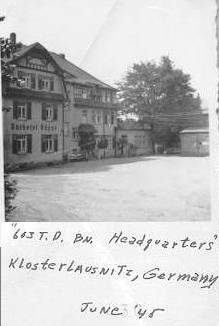 Just
short of Diedorf while going around a bend a civilian sedan was met coming
down the road the opposite way. The platoon halted and the car came to
a stop no more than ten feet from the platoon's lead jeep. Every gun on
the platoons six vehicles were trained on the car, the doors opened and
three German soldiers stepped out, the platoon fully expecting them to
raise their hands, when aware of the fact that about four machine guns
and numerous rifles carbines and pistols were practically down their throats.
But for some reason or other the Germans made a break; two machine guns
opened up -- one German was badly wounded and the other two taken prisoner.
The car which had been riddled during the shooting was pushed over the
bank and the platoon continued on. Upon reaching some woods between DIEDORF
and EIGENHEISEN the column was halted for a short time by higher Hdqs.
Just
short of Diedorf while going around a bend a civilian sedan was met coming
down the road the opposite way. The platoon halted and the car came to
a stop no more than ten feet from the platoon's lead jeep. Every gun on
the platoons six vehicles were trained on the car, the doors opened and
three German soldiers stepped out, the platoon fully expecting them to
raise their hands, when aware of the fact that about four machine guns
and numerous rifles carbines and pistols were practically down their throats.
But for some reason or other the Germans made a break; two machine guns
opened up -- one German was badly wounded and the other two taken prisoner.
The car which had been riddled during the shooting was pushed over the
bank and the platoon continued on. Upon reaching some woods between DIEDORF
and EIGENHEISEN the column was halted for a short time by higher Hdqs.
The 1st Platoon being out in front were stopped just short of an intersection. Walking up to the intersection Lt Fick noticed a German tank alongside the road about 400 yards from the intersection. A friendly tank was brought up, and with two rounds the enemy tank was destroyed. A few minutes later a German Captain and his driver were captured when they approached the intersection in a car, and also about 30 enemy soldiers who were walking down the road and failed to notice the platoon until they were right up to it. The column again moved out with the 1st platoon still in the lead. We had only gone a short ways when Sgt. Reed who was riding in the point jeep noticed a German Officer in the woods on his right flank. Just at that moment the German raised a bazooka and fired at the jeep. Luckily the jeep at that time stopped along the side of the road beside a tree. The round hit the tree, completely demolishing it. No one in the jeep was hurt. The platoon opened fire on the German but could not see him. Sgt. Reed called for the platoon to cease firing, and then crawled into the woods and finished the enemy officer off with the German's own gun. Friendly infantry troops were sent up to screen the woods and the platoon moved on to Eigenheisen. Outside of Eigenheisen a strong roadblock was encountered. The platoon, who had called infantry troops up to help, withdrew a short ways so friendly artillery could shell the strong point. Platoon stayed in Eigenheisen that night.
Platoon was alerted again at O600 April 4th, and were given orders to act as rearguard for the task force. This was the first time the platoon was not committed to take the lead. But armored cars were sent to the roads leading into town so as to cover the rear of the Task force as they pulled out. During this time a German fighter plane came overhead. Pfc. Joseph, who was manning one of the .50 caliber machine guns on the armored cars immediately recognized the enemy plane and commenced firing at it. His shooting proved accurate and the enemy plane was destroyed. The platoon remained in their positions until 1700 and then moved out to Oberdola, and spent the remainder of the evening at this point.
April 5th
at 0900 the platoon moved from Oberdola with the Task force CP group to
the city of Mulhausen which had already been cleared of the enemy by other
elements of the 6th Armored Div. Platoon remained here during the night.
Platoon
awoke at 0600 April 6th, but no orders to move out were given. Rations,
gas, and maintenance were taken care of during the day. Platoon was released
from Task Force "WARD" and again under control of Rcn. Co. Before retiring
for the evening all Platoon leaders and Platoon Sgt's were notified of
the situation and told to have the platoons ready to move out at 0730 to
a town Northeast at Mulhausen to report to the 86th Rcn. Squadron for orders
to help them screen and outpost all roads leading into Mulhausen.
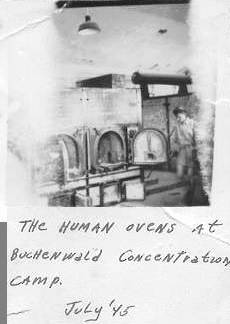 Platoon
moved out at 0730 April 7th with Rcn. Co. to Eurbach, and reported to the
86th for orders. 1st platoon was given the mission to outpost Solstadt.
Upon reaching Solstadt and looking over the situation it was decided that
Lt. Fick with the 1st section would block the other end. The following
morning April 8th, two Russians who were former prisoners of the Germans
gave the information to Lt. Fick that three German soldiers had spent the
night in some woods about 400 yds. from the platoon's position. Lt. Fick
organized a small patrol and went after them. Going into the woods the
patrol saw three enemy soldiers walking away from the patrol. Lt. Fick
called to them to surrender, and at this time a German soldier who was
hiding in the woods on the patrol's right flank, fired at Lt. Fick. wounding
him. Lt. Fick. although seriously wounded, kept calling to the Germans
in their own language to surrender, he also succeeded in killing two of
them after being wounded. The enemy soldiers finally surrendered, and Pfc.
Slack. after being sure that Sgt. Ferries could handle the prisoners, ran
for aid. A medical man arrived immediately and Lt. Fick was evacuated.
The 1st section in the meantime took all available vehicles and men, and
brought the prisoners back. There were 11 prisoners. Two Germans were killed.
The prisoners were taken back to Rcn. Co. That afternoon Lt. came out to
the Platoon informing them that he was the new Platoon Leader. Lt. Fick
had died on the way to the hospital. The men were quite upset when hearing
this news. Lt. Fick was very well liked and admired, both while as an enlisted
man and as an officer. His courage and leadership were of an outstanding
quality.
Platoon
moved out at 0730 April 7th with Rcn. Co. to Eurbach, and reported to the
86th for orders. 1st platoon was given the mission to outpost Solstadt.
Upon reaching Solstadt and looking over the situation it was decided that
Lt. Fick with the 1st section would block the other end. The following
morning April 8th, two Russians who were former prisoners of the Germans
gave the information to Lt. Fick that three German soldiers had spent the
night in some woods about 400 yds. from the platoon's position. Lt. Fick
organized a small patrol and went after them. Going into the woods the
patrol saw three enemy soldiers walking away from the patrol. Lt. Fick
called to them to surrender, and at this time a German soldier who was
hiding in the woods on the patrol's right flank, fired at Lt. Fick. wounding
him. Lt. Fick. although seriously wounded, kept calling to the Germans
in their own language to surrender, he also succeeded in killing two of
them after being wounded. The enemy soldiers finally surrendered, and Pfc.
Slack. after being sure that Sgt. Ferries could handle the prisoners, ran
for aid. A medical man arrived immediately and Lt. Fick was evacuated.
The 1st section in the meantime took all available vehicles and men, and
brought the prisoners back. There were 11 prisoners. Two Germans were killed.
The prisoners were taken back to Rcn. Co. That afternoon Lt. came out to
the Platoon informing them that he was the new Platoon Leader. Lt. Fick
had died on the way to the hospital. The men were quite upset when hearing
this news. Lt. Fick was very well liked and admired, both while as an enlisted
man and as an officer. His courage and leadership were of an outstanding
quality.
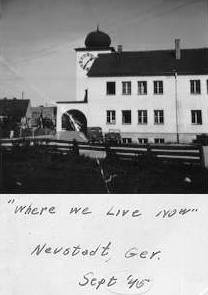 The
next day April 9th the Platoon remained in its position until late in the
afternoon when orders were given to report back to Rcn. Co. Platoon moved
back to Rcn. Co., and then travelling with the Company they moved back
to Mulhausin where Rcn. Co. was given the mission of patrol and security
duty in the city. This mission lasted until April 11th, at which time with
the 1st Platoon leading. Rcn. Co. again moved east, leading the way for
the Division. Upon reaching Zeitz stiff resistance was met. The first platoon
was given the mission of patrolling and reconnoitering the river south
of Zeitz for any bridges or possible crossings. April 13th the 1st
platoon crossed the river leading Task Force LAGREW, and moved into Zeitz,
then turned east again, moving fairly fast, meeting only scattered resistance
until reaching Tannenberg April 15th. The following day April 16th, Rcn.
Co. was put under Battalion control and moved back to their area at Rochlitz.
April 19th the entire 603 TD Bn. moved back to Zeitz and was given the
mission of maintaining law and order in the city. The 1st Platoon was given
the mission of handling civilian and soldier prisoners and patrolling an
area of the city. April 25th the 1st Platoon joined Rcn. Co. again, and
was billeted in a former German garrison where the Battalion was staying.
On May 9th a Battalion formation was held, and the Commanding Officer read
to the men -- an official notice from General Eisenhower to all troops
-- that hostilities had ceased in the European Theater of Operations.
The
next day April 9th the Platoon remained in its position until late in the
afternoon when orders were given to report back to Rcn. Co. Platoon moved
back to Rcn. Co., and then travelling with the Company they moved back
to Mulhausin where Rcn. Co. was given the mission of patrol and security
duty in the city. This mission lasted until April 11th, at which time with
the 1st Platoon leading. Rcn. Co. again moved east, leading the way for
the Division. Upon reaching Zeitz stiff resistance was met. The first platoon
was given the mission of patrolling and reconnoitering the river south
of Zeitz for any bridges or possible crossings. April 13th the 1st
platoon crossed the river leading Task Force LAGREW, and moved into Zeitz,
then turned east again, moving fairly fast, meeting only scattered resistance
until reaching Tannenberg April 15th. The following day April 16th, Rcn.
Co. was put under Battalion control and moved back to their area at Rochlitz.
April 19th the entire 603 TD Bn. moved back to Zeitz and was given the
mission of maintaining law and order in the city. The 1st Platoon was given
the mission of handling civilian and soldier prisoners and patrolling an
area of the city. April 25th the 1st Platoon joined Rcn. Co. again, and
was billeted in a former German garrison where the Battalion was staying.
On May 9th a Battalion formation was held, and the Commanding Officer read
to the men -- an official notice from General Eisenhower to all troops
-- that hostilities had ceased in the European Theater of Operations.
This page is maintained by Bruce Frederick, EMAIL
.
Last updated: July 20, 1999.